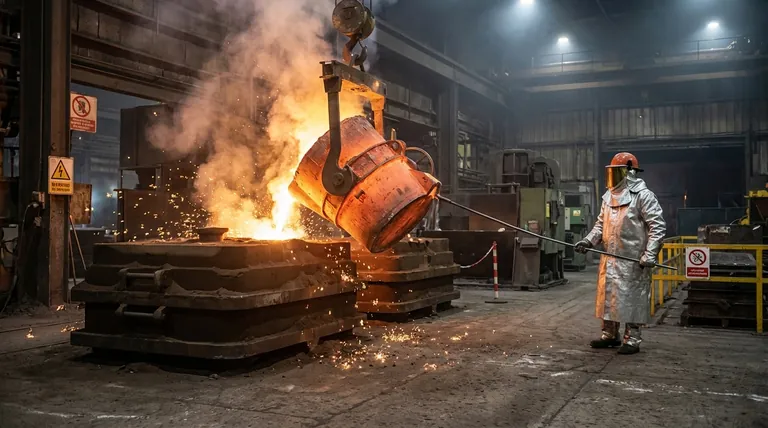溶融金属の主な危険性は、重度の火傷をはるかに超えています。これには、壊滅的な水蒸気爆発、有毒ガスやヒュームの放出、激しい輻射熱、および重大な火災リスクが含まれます。安全な作業環境を確立するためには、これらの各要因を理解することが不可欠です。
溶融金属に関する最も深刻な事故は、直接接触という明白な危険によって引き起こされることはめったにありません。むしろ、見過ごされがちな二次的な危険、特に金属と、たとえ少量であっても一見取るに足らない量の水との爆発的な相互作用によって引き起こされるのが典型的です。
熱的危険のスペクトル
溶融金属の最も直感的な危険は、その極端な温度です。例えば、鋼は約2800°F(1538°C)で扱われます。これらの温度は、複数の層の熱的リスクを生み出します。
直接接触による火傷
溶融金属が皮膚に飛び散ったりこぼれたりすると、即座に深く、生命を脅かす火傷を引き起こします。金属の高い熱容量は、非常に短時間で大量のエネルギーを伝達することを意味します。
標準的な衣類は保護にならず、溶けて皮膚に付着することで怪我を悪化させる可能性があります。
輻射熱への曝露
溶融金属に触れなくても、害を受ける可能性があります。炉、取鍋、および金属自体は、強烈な赤外線エネルギーを放射します。
この輻射熱は、遠距離からでも重度の火傷を引き起こし、視力に損傷を与え、時間の経過とともに熱ストレス、疲労、脱水症状を引き起こし、判断力と身体能力を低下させる可能性があります。
火災および引火のリスク
溶融金属がこぼれると、接触した可燃性物質は瞬時に発火します。これには、木材、紙、段ボール、可燃性液体、油圧油などが含まれます。
このリスクは、完璧な清掃と、溶解工場、鋳造所、または鋳造エリアに存在するすべての材料の慎重な監査を必要とします。

爆発反応の重大な危険性
壊滅的な事象の最大の可能性は、溶融金属と水または他の液体との相互作用から生じます。これは、堅牢な安全プログラムの主要な焦点です。
水蒸気爆発の解説
溶融金属が水を包み込むと、水は急速に蒸気へと変化します。この相変化には激しい膨張が伴い、水はほぼ瞬時に体積を1,600倍以上に増加させます。
これにより、強力な爆発が発生し、何トンもの溶融金属や設備破片が広範囲に飛散し、壊滅的な結果をもたらす可能性があります。引き金となるのは、取鍋に数滴の水が落ちたり、床の小さな水たまりに少量のこぼれた金属が触れるといったわずかなことでも起こりえます。
水の汚染源の一般的な例
水蒸気爆発を防ぐには、水分に対する執拗な警戒が必要です。主な発生源は以下の通りです。
- 炉に投入される湿った、または濡れたスクラップ金属。
- 溶融物に導入される濡れた工具、鋳型、または計器。
- 水冷式炉パネルまたは設備の漏れ。
- 雨、清掃、または漏れによる床の水たまり。
- 頭上の配管や屋根からの結露の滴下。
密閉空間の影響
ピット、溝、またはその他の密閉空間内で発生する水蒸気爆発は、著しく危険性が高まります。爆発力が集中して向けられるため、その破壊力が増幅されます。
大気および化学的危険性
目に見えないものも同様に危険な場合があります。金属を溶融させると、目に見えないが強力な様々な危険物質が空気中に放出されます。
有毒ガスと金属蒸気
金属を融点まで加熱すると、ヒュームと蒸気が放出されます。具体的な危険性は、処理される合金によって異なります。
亜鉛、カドミウム、鉛、マンガンなどの金属は有毒ガスを発生させる可能性があります。これらを吸入すると、即座に病気(金属ヒューム熱など)を引き起こしたり、神経系や内臓に影響を与える長期的な慢性的な健康被害につながる可能性があります。
窒息のリスク
多くの溶融作業では、溶融金属を酸素から保護し、酸化を防ぐために、アルゴンや窒素などの不活性ガスを使用します。
密閉された、または換気の悪い場所では、これらのガスが空気中の酸素を置き換える可能性があります。これにより、警告なしに意識を失う可能性がある、静かで致命的な窒息の危険が生じます。
フラックスとスラグによる化学火傷
不純物を除去するために、フラックスと呼ばれる物質が溶融物に添加されることがよくあります。その結果生じる廃棄物であるスラグも極めて高温です。
フラックスとスラグの両方が、非常に腐食性または酸性である可能性があります。飛沫は重度の熱傷に加えて化学火傷を引き起こし、治療を複雑にし、怪我を悪化させる可能性があります。
一般的な落とし穴と誤解
真の安全性には、基本的な認識を超えて、安全プロトコルにおける一般的な失敗点を理解することが必要です。
「軽微な」こぼれという神話
安全な、または軽微なこぼれというものはありません。少量の溶融金属でも、水源を見つければ壊滅的な水蒸気爆発を引き起こす可能性があります。すべてのこぼれは、制御不能な高リスクの事象です。
二次的な引火の見落とし
作業者は、取鍋と注入に集中しがちで、二次的な火災リスクを見落とすことがあります。少量の飛沫でも驚くほど遠くまで飛び、忘れられた油まみれのぼろ切れの山や漏れている油圧ラインに簡単に到達する可能性があります。
不適切な個人用保護具(PPE)
標準的な綿やポリエステルの衣類を使用することは重大な誤りです。アルミ加工されたものやその他の難燃性衣類など、特殊なPPEのみを着用する必要があります。この装備は、溶融金属の飛沫をはじき、引火に抵抗するように設計されており、脱出のための重要な数秒を提供します。
自己満足とリスクの常態化
これらの危険が日常的に存在する施設では、危険に対する慣れが生じ、危険な感覚が生まれることがあります。この「リスクの常態化」は、近道、手順の無視、そして警戒心のある安全文化からの逸脱につながります。
溶融金属の安全性への積極的なアプローチ
成功する安全戦略の実施は、各特定の危険に対する防御層を構築することです。
- 壊滅的な事象の防止に重点を置く場合:溶融金属が扱われたり輸送されたりするすべての場所から、水と水分を完全に排除することを最優先してください。
- 長期的な作業者の健康保護に重点を置く場合:有毒ガスや金属蒸気への曝露を制御するために、堅牢な換気システムと空気品質監視を導入し、維持してください。
- 日常の作業安全に重点を置く場合:当該エリアのすべての人員に、適切で特殊なPPEの着用を義務付け、緊急手順に関する厳格で継続的な訓練を実施してください。
これらの危険を克服することは、恐怖ではなく、プロセスへの深い敬意と、あらゆる段階での安全性への規律あるコミットメントを通じて達成されます。
要約表:
| 危険カテゴリ | 主なリスク | 主な予防策 |
|---|---|---|
| 爆発反応 | 水との接触による水蒸気爆発 | すべての水分源を排除 |
| 熱的危険 | 重度の火傷、輻射熱、火災 | 特殊なPPEを使用し、エリアを明確に維持 |
| 大気中の危険 | 有毒金属ヒューム、窒息のリスク | 堅牢な換気とガス監視を導入 |
| 化学的危険 | 腐食性フラックスとスラグによる火傷 | 適切な保護具で取り扱う |
溶融金属の壊滅的な危険からチームと施設を保護しましょう。 KINTEKは、高温金属加工に必要な堅牢なラボ機器と安全消耗品の提供を専門としています。当社の炉、PPE、およびヒューム抽出システムは、最大限の安全性と信頼性のために設計されています。安全を運任せにせず、爆発、有毒ガス、熱的リスクから操業を確実に保護するために、今すぐ専門家にお問い合わせください。
ビジュアルガイド

関連製品
- ロータリーチューブファーネス分割マルチ加熱ゾーン回転チューブファーネス
- 真空シール連続稼働ロータリーチューブ炉 回転チューブ炉
- 1400℃実験室用石英管炉 アルミナチューブ付き管状炉
- 実験室用真空チルト回転管炉 回転管炉
- 垂直管式石英管炉



















